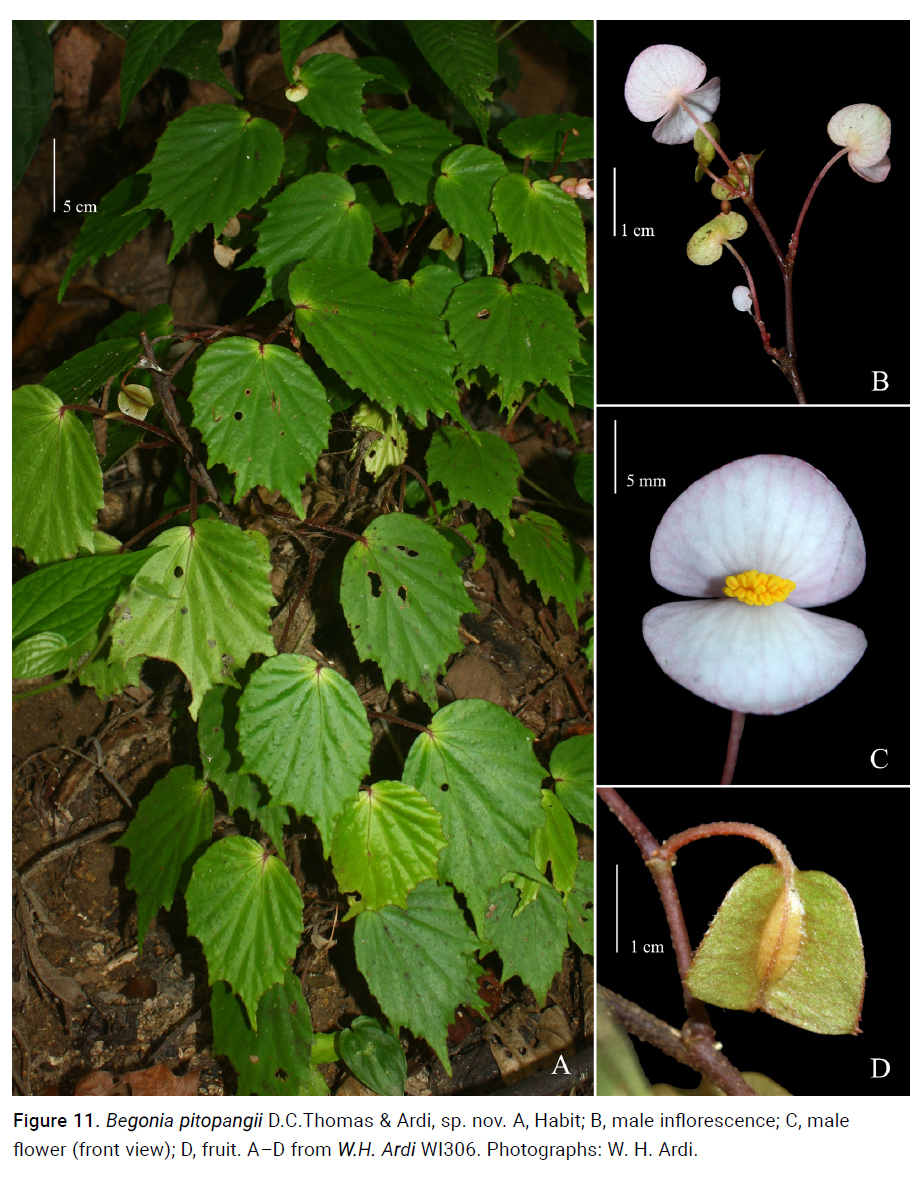Begonia pitopangii in Edinburgh J. Bot. 79(Begonia special issue, article 405): 32. 2022
Primary tabs

Diagnosis
- Most similar to Begonia strachwitzii Warb. ex Irmsch. in its growth habit (erect, up to 35 cm tall), densely hirsute stem, leaf morphology (an ovate to elliptic leaf lamina with palmate-pinnate venation) and female flowers with five tepals, but it differs in having male flowers in a thyrse composed of up to 4 partial inflorescences (monochasia) (vs composed of up to 6 partial inflorescences, which branch dichasially at the base), and a female inflorescence or infructescence with a shorter peduncle (1–2 mm long vs 5–10 mm long). (Ardi, W.H. & Thomas, D.C. 2022: Synopsis of Begonia (Begoniaceae) from the northern arm of Sulawesi and Sangihe Island, Indonesia, including three new species. – Edinburgh J. Bot. 79(Begonia special issue, article 405): 1-50. http://doi.org/10.24823/EJB.2022.405)
Description
- Perennial, monoecious herb, erect, up to c.35 cm tall. Stem branched; internodes 2–8.5 cm long, densely hairy with short bristly hairs, c.0.5 mm long. Leaves basifixed, alternate; stipules caducous, c.5 × 1.5 mm, elliptic, with a slightly prominent midrib on the abaxial surface, apex narrowed into bristle projecting up to 1 mm, brownish, abaxially hairy; petioles 4–8 cm long, concolorous with the stem, hairy, c.0.5 mm long; lamina 5.5–12 × 3–8 cm, asymmetrical, ovate to elliptic, base narrowly cordate or almost truncate, lobes rarely overlapping, apex acuminate, margin serrate to double serrate to shallowly lobed (up to 20% of lamina width), teeth bristle-pointed, adaxial surface green, prominent between the veins, glabrous to very sparsely bristly hairy between the veins, abaxial surface pale green, hairy on the veins only; venation palmate-pinnate, primary veins 6 or 7, actinodromous, secondary veins craspedodromous. Inflorescences: protogynous; female inflorescences 1(or 2)-flowered, positioned one node below the male inflorescences or single female flowers on multiple successive nodes below the male inflorescence, peduncles 1–2 mm long, sparsely hairy, bracts caducous; male inflorescence a thyrse consisting of 1–4 monochasial partial inflorescences, each with 2–6 flowers, peduncles of partial inflorescences up to 2 mm long. Male flowers: pedicels 10–17 mm long, reddish, glabrous; tepals 2, white, 5–10 × 9–12 mm, broadly ovate, base slightly cordate when young, truncate at anthesis, apex rounded, outer surface glabrous; androecium of c.31 stamens, yellow, filaments up to c.0.7 mm long, slightly fused at the very base, anthers up to c.1 mm long, oblong to narrowly obovate, dehiscing through unilaterally positioned slits that are c.1/2 as long as the anthers. Female flowers: pedicels c.6 mm long, red, moderately hairy with bristle hairs; tepals 5, subequal, c.5 × 3 mm, ovate, creamy reddish, glabrous; ovary (excluding wings) c.4.5 × 2 mm, cylindrical, red, glabrescent, wings 3, subequal, rounded at base, truncate at the apex, widest point c.2 mm apically. Fruits: peduncles c.2 mm long; pedicels 10–12.5 mm long, reddish, hairy; seed-bearing part cylindrical, 8–10 × 3.5–4 mm (excluding the wings), greenish-reddish, glabrous, dry capsule, dehiscent, splitting along the wing attachment, wing base rounded, apex truncate, up to 9 mm at the widest point (apically or subapically), wing margins ciliate. Seeds barrel-shaped, c.0.2 mm.
Habitat & Ecology
- The species grows in lowland secondary forest, in full shade, at 20–250 m elevation. (Ardi, W.H. & Thomas, D.C. 2022: Synopsis of Begonia (Begoniaceae) from the northern arm of Sulawesi and Sangihe Island, Indonesia, including three new species. – Edinburgh J. Bot. 79(Begonia special issue, article 405): 1-50. http://doi.org/10.24823/EJB.2022.405)
Conservation
- Data Deficient (DD). This species is known from only a single locality, the Mount Sojol Forest Reserve. The forests in the wider area are botanically very poorly explored and collected. Consequently, we assess this species as Data Deficient (IUCN Standards and Petitions Subcommittee, 2019). (Ardi, W.H. & Thomas, D.C. 2022: Synopsis of Begonia (Begoniaceae) from the northern arm of Sulawesi and Sangihe Island, Indonesia, including three new species. – Edinburgh J. Bot. 79(Begonia special issue, article 405): 1-50. http://doi.org/10.24823/EJB.2022.405)
Distribution (General)
- Indonesia: endemic to Sulawesi, Central Sulawesi (western North biogeographical region), Mount Sojol (Ardi, W.H. & Thomas, D.C. 2022: Synopsis of Begonia (Begoniaceae) from the northern arm of Sulawesi and Sangihe Island, Indonesia, including three new species. – Edinburgh J. Bot. 79(Begonia special issue, article 405): 1-50. http://doi.org/10.24823/EJB.2022.405)A
Etymology
- The specific epithet of Begonia pitopangii is in honour of Professor Ramadanil Pitopang, a plant taxonomist at University Tadulako, Palu, who is an expert on the Sulawesi flora and has collected extensively on the island. (Ardi, W.H. & Thomas, D.C. 2022: Synopsis of Begonia (Begoniaceae) from the northern arm of Sulawesi and Sangihe Island, Indonesia, including three new species. – Edinburgh J. Bot. 79(Begonia special issue, article 405): 1-50. http://doi.org/10.24823/EJB.2022.405)B

